The environmental pollution caused by plastic waste has been escalating worldwide. Plastics are extremely familiar to people, and global production and use of these products continue to grow as they improve the convenience of our daily lives and society. In line with this trend, the volume of plastic waste has continued to increase.
Plastics that have leaked into the environment are resistant to decomposition. "Microplastics," which are fragmented plastic pieces smaller than five millimeters in size, flow and drift from land and rivers into the ocean, absorbing harmful chemicals that eventually enter the bodies of marine organisms. There are also indications that microplastics may negatively impact human health throughout the food chain.
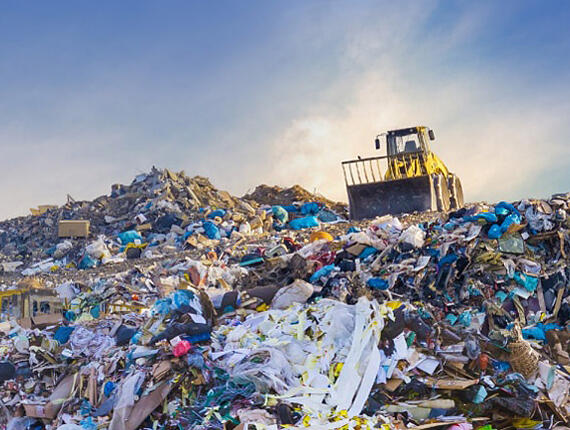
Provided by the UNEP; the location and time of the photograph are unknown
In an effort to address this global expansion of plastic waste pollution, an international convention is being drafted under the eye of the United Nations. Two sessions of the Intergovernmental Negotiating Committee have been held to date, and a draft convention has been formulated with an aim toward its finalization by the end of 2024. However, the question remains whether the convention will restrict the discharge and disposal of plastic waste in any way and whether its contents will be legally binding. No foresight is observed on this great issue, and future negotiations among countries will inevitably be difficult.
107 million metric tons of plastic enter the environment each year
In May of last year, the United Nations Environment Programme (UNEP) published a report titled "Turning off the Tap," which provides an overview of the global plastic waste pollution issue. The cover of the report shows an image of plastic waste flowing from a tap, emphasizing the need to halt the leakage of plastic waste into the environment.
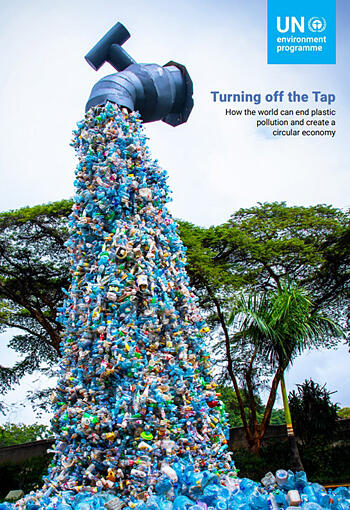
Provided by the UNEP
The report first notes that the global production and use of plastics have increased dramatically since 1950, with 430 million metric tons produced per year. Of these, more than two-thirds are single-use products (short-lived products) that immediately become waste (litter), and the volume continues to increase. If plastic production continues at this rate, the volume will triple the current level by 2060. Since the volume produced and used in developing countries will inevitably increase in the future, the total volume of waste in the world will grow unless developed countries reduce their production and use.
According to the report, approximately 238 million metric tons of plastic produced and used had become waste as of 2020, and approximately 107 million metric tons had entered the environment, including the ocean. Furthermore, the volume of generated waste will exceed 400 million metric tons by 2040, and the volume of waste entering the environment is expected to increase.
The report indicates that a five-year delay in specific waste reduction measures may lead to a waste increase of 80 million metric tons. If no action is taken, the global social and environmental costs are estimated to range between US$300 billion and US$600 billion per year. Some estimates suggest that this range could exceed US$1.5 trillion. However, it is estimated that the cost of significantly reducing the volume of waste by 2040 would only be approximately US$65 billion.
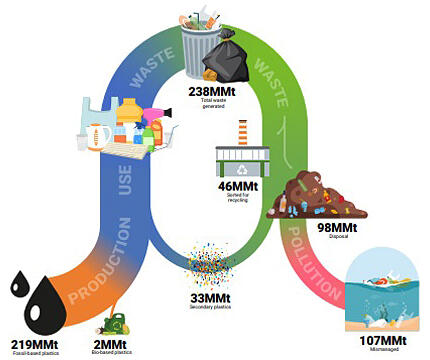
Provided by the UNEP
UNEP report indicates that an 80% reduction by 2040 is possible
The "Turning off the Tap" report conveys the escalation of global plastic waste pollution, examines waste reduction strategies, and analyzes their effectiveness in reducing waste compared with the scenario of no action taken. The report shows that significant reductions can be achieved through policy changes and the use of existing technologies.
The report suggests that plastic waste could be reduced by up to 80% by 2040 through a transformation of the market from one that uses single-use products to one that uses reusable products, namely, from a "single-use economy" to a "circular economy." The report emphasizes the need to eliminate unnecessary uses, such as excessive packaging, and to shift to the concepts of reuse, recycle, reorient and diversify.
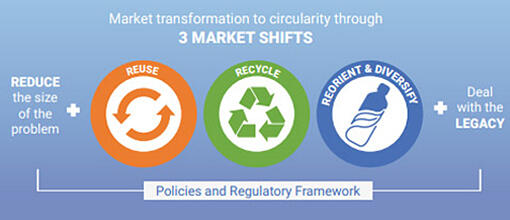
Provided by the UNEP
A projected 30% reduction by 2040 would be achieved by first eliminating excessive packaging and non-reusable plastic products from the market and strengthening approaches to increase recycling, such as by promoting the use of refillable bottles and reusable bags. A 20% reduction can be achieved by increasing the percentage of recyclable plastics from the current 20% to 50%. Furthermore, a 17% reduction could be achieved by replacing packaging and bags with products made of compostable materials and other alternatives. The remaining 13% could be reduced by, for example, eliminating the export of plastic waste to countries where such waste is poorly managed.
Such a transformation to a circular economy will require investments in the production of alternative materials and the establishment of recycling facilities. However, if reductions in the cost of conventional product production and other expenses are anticipated, the investment could save a total cumulative cost of US$1.3 trillion by 2040.
The report notes that proactive measures will provide opportunities for technological innovation in developing countries as well as have social and economic benefits, including the creation of 700,000 additional jobs by 2040. The report emphasizes that proactive measures against plastic waste are effective for preventing damage to human health, mitigating climate change, and reducing the carbon dioxide emissions generated during the incineration of used products.
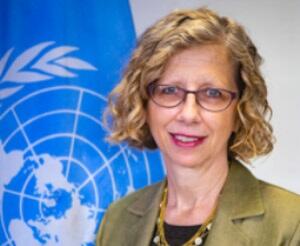
Provided by the UNEP
Convention emerges from concerns raised among developed countries
The concept development of an international convention aimed at preventing global plastic waste pollution has been driven by concerns raised among developed countries regarding the issue of plastic waste entering the ocean. Developed countries have produced and used large quantities of plastic products in line with their economic development, generating a large amount of plastic litter. According to the Organisation for Economic Co-operation and Development (OECD), an estimated 8 to 12 million metric tons had reached the ocean by 2015, and this amount is predicted to exceed the total weight of fish by 2050.
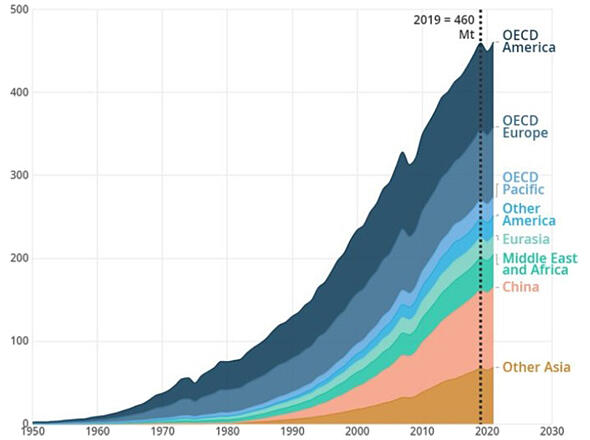
Provided by the OECD
"The G7 Action Plan to Combat Marine Litter" was first formulated among developed countries at the G7 Schloss Elmau Summit held in Germany in 2015. In the following year of 2016, a statement to recognize that efforts on resource efficiency and the 3Rs (Reduce, Reuse, Recycle) contribute to the prevention and reduction of plastic waste generation was included in the Leaders' Declaration of the G7 Ise-Shima Summit chaired by Japan. Subsequently, the G7 and Group of Twenty (G20) summits successively addressed the issue of marine plastic litter.
The G7 Charlevoix Summit held in Canada in 2018 adopted the "Ocean Plastics Charter" that included numerical targets for reducing plastic litter in the ocean. However, Japan and the United States refused to sign the charter. As this policy decision drew international criticism, the Japanese government shifted to a more proactive stance at the G20 Osaka Summit in the following year (2019), formulating the "Osaka Blue Ocean Vision," which aims to reduce additional pollution by marine plastic litter to zero by 2050.
In response to this international movement led by developed countries, member states of the United Nations agreed at the United Nations Environment Assembly in March 2022 to establish an international convention to address the serious issue of plastic waste pollution. The Leaders' Communiqué of the G7 Hiroshima Summit in May 2023 included a commitment to end plastic pollution, with the goal of reducing additional plastic pollution to zero by 2040, and the expectation for an Intergovernmental Negotiating Committee to establish a legally binding international convention by the end of 2024.
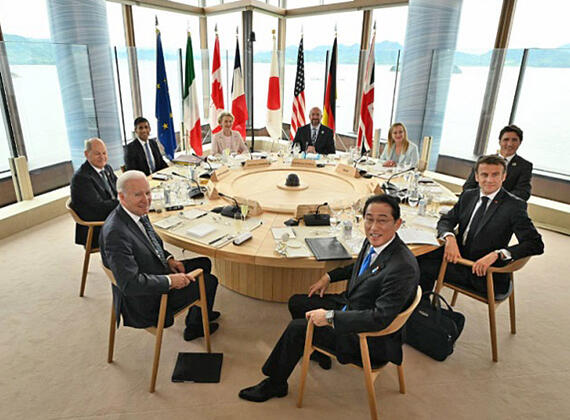
Provided by the Ministry of Foreign Affairs
The draft includes "loose" options
The first session of the Intergovernmental Negotiating Committee to draft an international convention was held in Uruguay from November to December 2022, and the second session was held in France from May to June last year. Representatives from approximately 170 countries attended these sessions. On the basis of the discussions and confirmations made during the two sessions, the Secretariat, led by the Chair of the Committee, compiled a draft of the convention and published it in September of last year.
The document, referred to as the "Zero Draft," lacks effectiveness in addressing the issue. It reflects differences in opinions among countries on many crucial aspects, such as the content of regulations and the nature of financial support, and merely proposes several options.
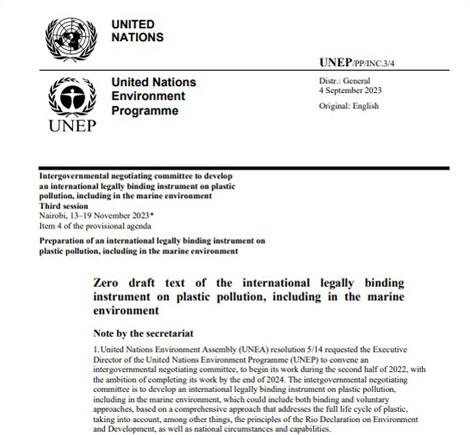
Provided by the Secretariat of the Intergovernmental Negotiating Committee/UNEP
In the Introduction section of the draft document, two options for the "Objectives of the Convention" are discussed. These objective options are "to end plastic pollution, including in the marine environment, and to protect human health and the environment," and "to protect human health and the environment from plastic pollution, including in the marine environment." Although it is difficult to understand, the difference between these two options is whether or not to include the clause "to end plastic pollution." Although it is natural for a convention to clearly include the directive "to end," the opposition to the language reflects the reluctance of certain developed countries to undertake specific regulatory measures.
In relation to this "objective" clause, the draft further includes sub-options, such as "through the prevention, progressive reduction, and elimination of plastic pollution throughout the life cycle of plastics by 2040" and another option with similar wording but without a specific timeframe. Additionally, there are certain options for reduction: one proposes a strict regulatory approach, stating that "each Party shall not allow its production and supply of primary plastic polymers to exceed the reduction target," whereas another option proposes a loose approach, stating that "Parties shall take the necessary measures to manage and reduce the global production and supply of primary plastic polymers."
With regard to single-use products, which were noted in the UNEP report, the draft includes one option to set a timeframe to prohibit their manufacture, sale, import, and export. Another option is a looser proposal to entrust the determination of the timeframe to individual countries. Regarding financial support for countermeasures, the draft includes the option of establishing a fund at the request of developing countries and the option of using existing funds, considering the opinions of developed countries. As mentioned above, various options aimed at enhancing efforts in each country are discussed in critical clauses.
The draft will be discussed at the third session of the Intergovernmental Negotiating Committee, which will take place in Kenya on November 13, 2023. However, there is no prospect of a concrete convention outline at this session due to the significant disagreement among the countries over the different options. Although five meetings are scheduled before the deadline for formulation at the end of 2024, there are already speculations that it will be difficult to complete the process by then.
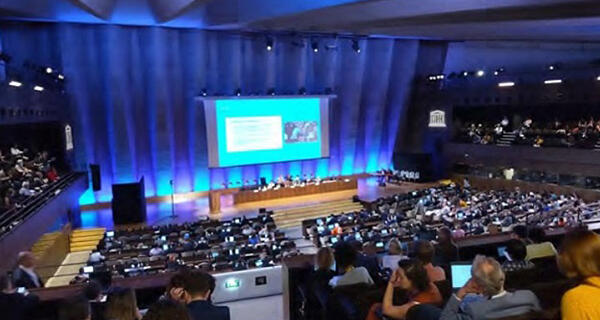
Reducing the total volume and increasing the reuse rate are pressing issues
It is often quoted that "8 million metric tons of plastic waste enter the ocean every year." The Japanese Ministry of the Environment cites this figure as an estimated volume by an international organization. The OECD has recently suggested that a significant volume of plastic waste released into the environment ends up accumulating in land areas, lakes, and rivers and that the amount of plastic waste entering the ocean is only approximately 1.7 million metric tons. Nevertheless, it is undoubtedly a serious environmental issue.
According to Dr. Yasuhiko Hotta, Program Director and Principal Policy Analyst at the Institute for Global Environmental Strategies (IGES), approximately 80% of leaked plastic waste is attributed to improper waste management on the ground. He estimated that 20,000 to 60,000 metric tons enter the ocean from Japan. According to Dr. Hotta, 79,000 metric tons of plastic debris are floating in the "Great Pacific Garbage Patch," an area located close to the center of the North Pacific Ocean. Of the amount stated above, microplastics account for 8%, and Japan could be identified as the country of production origin for approximately 30%. This research finding calls into question Japan's responsibility as a maritime nation.
Japan is the second-largest producer of plastic packaging waste per capita after the United States. At a cabinet meeting in June 2018, the government approved the "Fundamental Plan for Establishing a Sound Material-Cycle Society," which aimed to reduce plastic waste. In May of the following year, the "Resource Circulation Strategy for Plastics" was formulated, and in June 2021, the "Act on Promotion of Resource Circulation for Plastics" was enacted.
This new act was enforced in April 2022, initiating a system to treat various types of plastic waste generated by households as recyclable waste, thus allowing municipalities to collectively collect them, and requiring providers of single-use products to take reduction measures.
Although a detailed evaluation of the effectiveness of this new system has not yet been carried out, a survey conducted a few years ago revealed that as many as 2 billion plastic bottles remained uncollected annually. This suggests that it is early to say that Japanese society has abandoned the use of single-use plastics. Most plastic products are collected, but a significant portion is incinerated. Although incineration includes the use of heat, the "reuse" rate emphasized by the UNEP is still estimated to be approximately 20%. Reducing the total amount of plastic waste and increasing the domestic reuse rate remain urgent issues.
It is crucial to change the awareness of each individual of the many plastic products, such as plastic bottles, that they use every day. Additionally, it is necessary not to treat recyclable products as disposable items and to rethink our extremely plastic-dependent lifestyles.
Japan to take a leading role in international convention negotiations
Japan is urged to shift to a "reuse" and "circular" economy that creates new added value while utilizing resources in a circular manner. Simultaneously, there is a call for support from developing countries in Southeast Asia, which are viewed as the key to solving the issue of plastic waste pollution. Hotta and Senior Researcher Dr. Aoki of IGES agree that the thorough management of plastic waste in developing countries, particularly in Asia, is the most crucial factor in solving the global plastic waste issue.
According to officials knowledgeable about the negotiations among the countries involved in creating the convention, Europe and other countries are calling for the establishment of common global standards, such as plastic waste reduction targets, whereas countries such as the United States, China, and Japan are in favor of entrusting each country with a voluntary reduction plan, similar to the Paris Agreement to combat global warming.
At the G20 Osaka Summit in 2019, Japan took the lead in adopting the Osaka Blue Ocean Vision, which led to the subsequent development of a convention. Therefore, Japan is expected to play a leading role in the creation of a legally binding and highly effective convention for reducing plastic waste.
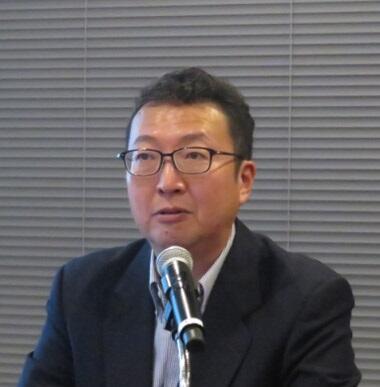
(at a lecture hosted by the Japanese Association of Science and Technology Journalists on October 11, 2023)
(UCHIJO Yoshitaka: Science Journalist, Kyodo News Visiting Editorial Writer)
Original article was provided by the Science Portal and has been translated by Science Japan.




